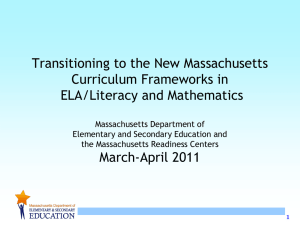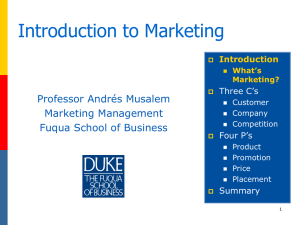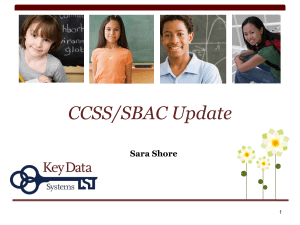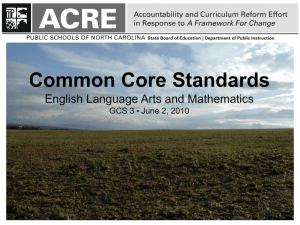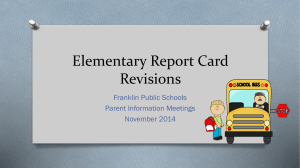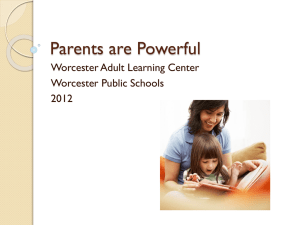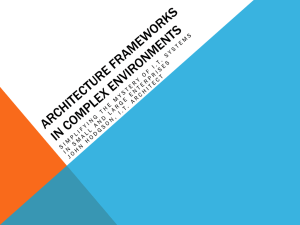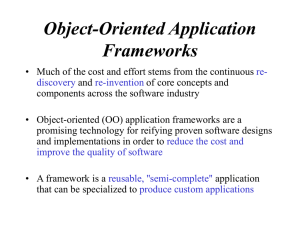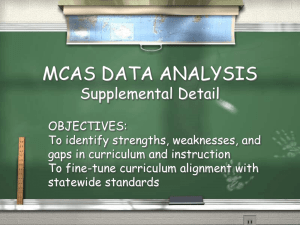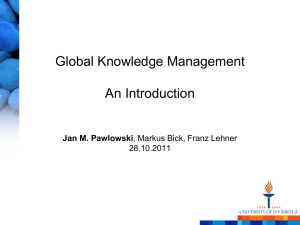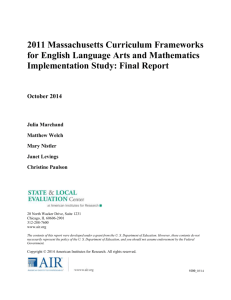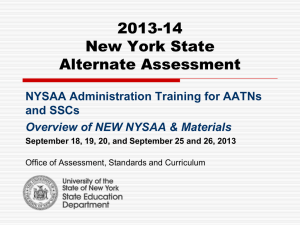File - Merrymount School PTO
advertisement
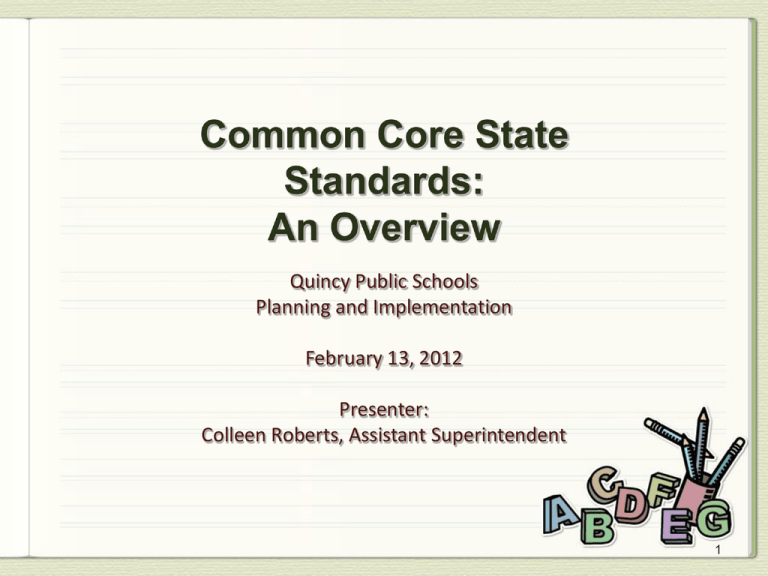
Quincy Public Schools Planning and Implementation February 13, 2012 Presenter: Colleen Roberts, Assistant Superintendent 1 Purpose of Standards Overview Timeline What are the Standards? ELA Highlights Math Highlights pg. 3 pgs. 4-9 pgs. 10-13 pgs. 14-21 pgs. 22-30 QPS Planning for Implementation Curriculum Alignment and Mapping Curriculum Needs Assessment Professional Development pg. 32 pg. 32 pg. 33 Implementation Timeline - DESE For More Information pg. 34 pg. 35 2 “These Standards are not intended to be new names for old ways of doing business. They are a call to take the next step. It is time for states to work together to build on lessons learned from two decades of standards based reforms.” Common Core State Standards for Mathematics (page 5) 3 Spring 2009 – National Governor’s Association and the council of Chief State School Officers propose development of a common core of K-12 state standards in English Language Arts and Mathematics July 2010 – Common Core state standards adopted in Massachusetts to replace the current Massachusetts Curriculum Frameworks in ELA and Math contingent upon augmenting and customizing the Common Core 43 States and the District of Columbia have adopted these standards 4 December 2010 – DESE board votes on adopting additional standards to the Common Core State Standards Up to an additional 15% of standards may be added from the state to enhance Common Core Math - DESE recommendation: 4% additional standards including 10 standards for K-8 additions and 9 standards for high school additions ELA – DESE recommendation: 2.5% or 27 additional standards including Pre-K standards 5 Spring 2011 – New Massachusetts State Curriculum Frameworks released. MCAS Assessment for 2011 - based solely on the current ELA and Mathematics Frameworks 6 Fall 2011 – Spring 2012 New Massachusetts Frameworks based on the Common Core distributed to all staff Professional Development occurs throughout the school year for all staff regarding “unwrapping” the standards for ELA/Literacy (including Science and Social Studies) and Math Spring 2012 MCAS for Spring 2012 will be based on standards common between current and new frameworks Some test items will be based on the new frameworks but may not be included in scoring (pilot items) Science will remain the same 7 School Year 2012-2013 MCAS for Spring 2013 will be based on standards common between current and new frameworks Some test items will be based on the new frameworks School Year 2013-2014 MCAS based fully on the New Massachusetts Frameworks based on the Common Core 8 School year 2014-2015 The national test – Next Generation Assessment (NGA) - will be given to all students Assessments will be for students in grades 3-11 Tests are expected be given online 9 10 The New ELA/Literacy and Math Curriculum Frameworks, comprised primarily of the Common Core State Standards, were written explicitly to define the knowledge and skills that students must master to be college and career ready by the end of high school. The Standards Are aligned with College and Career readiness Are clear, understandable and consistent Include rigorous content and application of knowledge through higher-order thinking skills Build upon strengths and lessons of current state standards Are informed by other top performing countries, so that all students are prepared to succeed in our global economy and society Are evidence based 12 College and Career Readiness Anchor standards These standards demonstrate broad expectations for all students to be prepared for life after high school K-12 Grade Specific end-of-the-year expectations These standards are more specific, and state what students need to be able to do and understand at the end of each grade level 13 14 What’s Different about the ELA Common Core? • The emphasis on college and career readiness • Intentional coherence between the standards for reading literature and informational text • The emphasis on finding good evidence and using it precisely “Read like a detective, Write like a reporter” • Detailed standards on writing arguments, explanations and narratives • Standards for literacy in history/social studies, science, and technical subjects 15 Four Strands are included: Reading Writing Speaking and Listening Language 16 Reading Balance of literacy and Informational texts Inclusion of text complexity Writing Emphasis on argument and informative/explanatory writing Writing about sources Speaking and Listening Inclusion of formal and Informal talk Language Stress general academic vocabulary (Tier 2 words) Stress domain-specific vocabulary (Tier 3 words) 17 Reading Literature Informational Text Foundational Skills (Grades K-5) 18 Writing Text Types and Purpose* Production And Distribution Of Writing* Research to Build And Present Knowledge* Range of Writing*: starts in Grade 3 * Based on the College and Career Readiness Anchor Standards 19 Speaking And Listening Comprehension And Collaboration* Presentation of Knowledge and Ideas* * Based on the College and Career Readiness Anchor Standards 20 Language Conventions of Standard English* Knowledge of Language* Vocabulary Acquisition and Use* Vocabulary: •General academic words and phrases (Tier 2 words) •Domain-Specific words and phrases (Tier 3 words) * Based on the College and Career Readiness Anchor Standards 21 22 The new standards support improved curriculum and instruction due to increased: – FOCUS, via critical areas at each grade level – COHERENCE, through carefully developed connections within and across grades – CLARITY, with precisely worded standards that cannot be treated as a checklist – RIGOR, including a focus on College and Career Readiness and Standards for Mathematical Practice throughout Pre-K-12 Focus and Coherence Balance of Concepts and Skills Mathematical Practices College and Career Readiness 24 Mathematics Math Practice K-8 Grade Level Progress Focal Points Math Content High School Conceptual Categories 25 “Expertise” for students at all grades Make sense of problems and persevere in solving them Reason abstractly and quantitatively Construct viable arguments and critique the reasoning of others Model with mathematics Use appropriate tools strategically Attend to precision Look for and make use of structure Look for and express regularity in repeated reasoning 26 Each Grade level includes: Introduction Counting and Cardinality (Kindergarten) Operations and Algebraic Thinking Number and Operations – (Fractions starting in Grade 3) Measurement and Data Geometry Grades 6-8 – Statistics and Probability 27 Conceptual Categories Number and Quantity Algebra Functions Geometry Modeling Statistics and Probability 28 Two model course pathways: Traditional: Algebra I, Geometry, Algebra II Integrated: Mathematics I, Mathematics II, Mathematics III Additional Courses: Precalculus, Advanced Quantitative Reasoning 29 At the end of either pathway, students: Will have studied the same standards Are prepared for additional courses such as Precalculus or Advanced Quantitative Reasoning Are College and Career Ready “College Ready” for entry level credit bearing course 30 31 Curriculum Alignment -2011-2012 Crosswalk Documents from DESE Curriculum Mapping Curriculum Guides/Pacing Curriculum Needs Assessment-2012-2013 Filling in the “Gaps” with current Curriculum Purchase of Supplementary materials Timeline for piloting newer materials from publishers 32 Professional development workshops and courses beginning in Spring 2011 Including teachers and principals in all aspects of this change-over to the new Massachusetts Curriculum Frameworks Work with Curriculum and Professional Development Teams Vertical Teams- Site based and District Teams Release Time Contractual Time 33 DESE Summer 2011 to SY 2014 Model curriculum units and performance tasks are being developed and piloted; curriculum units will be refined and shared on ESE website by the Spring of 2012 Districts 2011-2012 Quincy and other districts will continue making transition to the new MA Curriculum Frameworks 2012-2013 Transition to new MA State Curriculum Frameworks to be complete All teachers will use these new Frameworks in their standards-based classrooms 34 http://www.doe.mass.edu/candi/commoncore News about Massachusetts additions, professional development and resources for alignment As you review this information and find that you have questions, please feel free to contact: Colleen Roberts, Assistant Superintendent Email: croberts@quincy.k12.ma.us Phone: 617-984-8760 35
